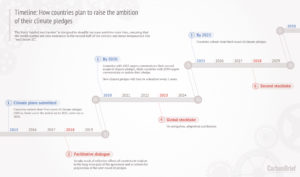COP22: In the US, Businesses Must Lead the Way to a Low Carbon Economy
The 22nd Annual Conference of the Parties (COP22) to the United Nations Framework Convention on Climate Change (UNFCCC) held in Marrakech, Morocco, occurred during the same time as the United States 2016 presidential election. COP22 served in part to discuss how to implement the Paris Agreement. After Trump’s upset, many asked, what would we do if the world’s second largest polluter actually left the Paris Agreement, like Trump promised in his campaign?
The news in the following days stated that the world would continue to work towards the goals of the Paris Agreement, which center around keeping the global average temperature increase to well below 2°C above pre-industrial levels, with or without the US. But, could we actually hit those goals, which are already extremely aggressive, without one of the major players? We’ve already seen evidence of warmer temperatures being realized at a faster rate than predicted, as reports have suggested a current global temperature increase of over 1°C1, but the Paris Agreement is doable with the world’s immediate cooperation.
During the second week of COP22 we heard from US Secretary of State John Kerry. He reassured everyone at COP22 that “a majority of US Citizens support the US taking action on climate change” 2. This means, not only do the American people want to see climate action, but so do American businesses. This was very apparent in the second week of COP22 when more than 360 businesses wrote an open letter to President-elect Trump, President Obama, Members of the US Congress, and Global Leaders at COP22 in Marrakech, stating they would back a low carbon USA with low-carbon policy, investment in a low-carbon economy, and advocate for continued US Participation in the Paris Agreement3. This was further echoed by Kerry when he stated “Market forces, rather than policy, would ensure a transition to a low carbon world”2.
So, what happens next, specifically for the US? Do we rely on market forces and capitalism to ensure we meet the goals outlined in the Paris Agreement? Or do we continue to put pressure on President-elect Trump so he adheres to the Paris Agreement, and doesn’t erase the climate policy put in place over the last 8 years by Obama’s administration? Can we do both of these things? I believe the answer is that we must continue to put pressure on the US government, and businesses have to continue to lead by example by creating low carbon and carbon free economies that will influence national policy.
Nigel Topping, CEO of We Mean Business, present at COP22, explains in a podcast with GreenBiz350 that businesses need to do 3 things when it comes to climate policy: commit, demonstrate and advocate4.
Commit
Businesses need to commit to low-carbon and carbon free goals as central to business strategy. We’ve already seen a number of businesses do this, such as many of the companies that signed the Low Carbon USA letter. These goals also need to be achievable. This means the goals must be backed by science, to show that the goals are feasible. The goals also need the proper financial support.
Science based goals and the proper financial backing were both themes at COP22; in fact, these two topics were discussed during the opening remarks of the convention. Ms. Patricia Espinosa, Executive Secretary of the UNFCCC, commented that “finance is flowing, but we know it is not enough” and that “nationally determined contributions now need to be integrated into national policies and investment plans”5. Mr. Hoesung Lee, Chair of the Intergovernmental Panel on Climate Change (IPCC) noted that “COP22 is to be the COP of action” and it is his hope “that the future reports of the IPCC will provide a robust foundation for the work of policymakers, so that implementation of the Paris Agreement can be based on sound science”6.
Demonstrate
Businesses need to demonstrate that commitments are being followed with action. An example would be highlighting in a Corporate Social Responsibility (CSR) report and a press release that low carbon goals are backed by enough finances, and showing through scientific evidence that emissions are being decreased and that the business is on track to meet science based goals.
Businesses could also take this a step further by trying to change the conversation on climate action through an advertising campaign. As consumers are becoming increasingly aware of the consequences of climate change, they are more likely to purchase products in line with these concerns. There is even a target segment name for these consumers – LOHAS (Lifestyles of Health and Sustainability). The U.S. market for these consumers was valued at $209 billion in 20057 and has only grown since then. If a business can demonstrate they are decreasing carbon emissions and therefore advertise their brand as a sustainable alternative, consumers within the LOHAS segment (which I believe will only continue to increase) will drive the market to favor these sustainable businesses.
Advocate
It is important for businesses to work together with policy makers to identify the policy changes that would be needed for both businesses and countries to hit their science based goals. Nigel Topping explained during the GreenBiz350 podcast one of the challenges of the Paris Agreement. The aggressive average temperature increase goal outlined in the Paris Agreement is lower than what the countries can currently achieve, which is an average global temperature increase of about 2.7°C. Therefore a “ratchet mechanism”8 has been implemented. This mechanism allows countries to meet every 5 years to review progress on the Paris Agreement goals, and discuss how plans need to be adjusted in order to hit the goals. Businesses need to be a central part of these discussions as they should be a key voice in shaping policy in order to achieve these goals. The timeline of the ratchet mechanism can be seen here8:
These 3 actions – commit, demonstrate, and advocate – are what will ultimately help businesses hit their climate change goals, lead by example in the US by creating low-carbon economies, and influence policy, especially in an administration with climate change deniers and believers in fossil fuel economies. It is true we cannot assume what will happen under the new US administration until early 2017 after inauguration, but businesses need to be prepared to stand up and defend climate change policy, and businesses must lead the transition of the US to a carbon free economy.
Sources:
- McKie, Robin (6 August 2016) “Scientists warn world will miss key climate target” in The Guardian. Retrieved 26 November 2016 from: https://www.theguardian.com/science/2016/aug/06/global-warming-target-miss-scientists-warn
- McGrath, Matt (16 November, 2016) “Kerry: ‘Overwhelming majority’ back US climate action’” in BBC News. Retrieved: 17 November 2016 from http://www.bbc.com/news/science-environment-38005101?ocid=socialflow_twitter
- Business Backs Low-Carbon USA, Open Letter. Retrieved: 17 November 2016 from http://www.lowcarbonusa.org/
- Makower, Joel & Hepler, Lauren (10 November 2016) “GreenBiz 350 Episode 52 ‘Sustainability in the Trump era? Plus, COP22 kick-off’” Retrieved: 11 November 106 from https://www.greenbiz.com/article/episode-52-sustainability-trump-era-plus-cop22-kick
- Espinosa, Patricia (7 November 2016) “Opening Address at the Twenty-second session of the Conference of the Parties (COP 22)” Retrieved 8 November 2016 from http://newsroom.unfccc.int/media/777621/cop22_openingaddress_espinosa.pdf
- Lee, Hoesung (7 November 2016) “Opening of COP22: Statement by the Chair of the IPCC, Hoesung Lee” Retrieved 8 November 2016 from https://www.ipcc.ch/pdf/unfccc/cop22/cop22_opening_chair_statement_final.pdf
- Friend, Gil (May 2009) The Truth About Green Business, Pearson Education ltd.
- Yeo, Sophie (19 January 2016) “Timeline: the Paris agreement’s ‘ratchet mechanism’” in Carbon Brief. Retrieved: 26 November 2016 from https://www.carbonbrief.org/timeline-the-paris-agreements-ratchet-mechanism





.png)
].gif)
.png)
].png)
].png)
].png)
.png)
].png)
.png)
